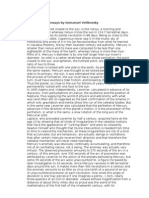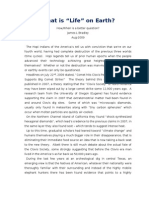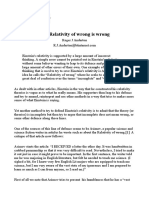Stiebing, Ancient Astronauts 1992
Stiebing, Ancient Astronauts 1992
Uploaded by
Herbert Adam StorckCopyright:
Available Formats
Stiebing, Ancient Astronauts 1992
Stiebing, Ancient Astronauts 1992
Uploaded by
Herbert Adam StorckCopyright
Available Formats
Share this document
Did you find this document useful?
Is this content inappropriate?
Copyright:
Available Formats
Stiebing, Ancient Astronauts 1992
Stiebing, Ancient Astronauts 1992
Uploaded by
Herbert Adam StorckCopyright:
Available Formats
Ancient Astronauts, Cosmic Collisions and Other Popular Theories About Man's Past
by William H. Stiebing, Jr.
(Buffalo, New York: Prometheus Books 1984) 217 pp $18.95 hardback, $9.95 paperback
This book critically reviews several popular theories and ideas that have gained wide currency among the general public. It is written by W.H. Stiebing, Jr. an associate professor of history at the University of New Orleans. The popular concepts dealt with by Stiebing are the universality of the Deluge, Atlantis, Cosmic Catastrophism, Ancient Astronauts, the mysteries of the pyramids and early voyages to the Americas. A concluding chapter summarizes some elements common to all of the above theories. In this chapter he cites the poor nature of the evidence: simple answers to complex problems and a pervasive anti-establishment rhetoric as being examples of these common elements. Stiebing goes on to conclude this same chapter with some reflections on why these views have gained such popularity; he believes the growing popularity is due primarily to the communications gap between the scholarly and general community. Stiebing's handling of the idea of a universal flood is essentially even-handed. He brings to bear deficiencies in the interpretations of myths concerning the flood: overstatement of the evidence and difficulties in locating the alleged landing place of the Ark. Stiebing makes an acceptable case for most flood stories being regionally and temporarily disparate. He also notes that many flood stories cited in favor of universality can be understood as local in character or as having been brought by early Christian proselyzers and then re-grafted into the tribal tradition. Stiebing also finds that some evidence is overstated, as in the case of the mass and instant destruction of the mammals in Siberia; which is believed to be proof of a universal flood. Stiebing brings expert testimony to bear on this issue. That testimony asserts that such deaths were far less instantaneous than some believe, as decay was present in these corpses before they froze. Also at least five locations for the Ark are noted, of which the one on the mountains of Ararat on the Turkish-Russian border, according to a number of lines of inquiry by Stiebing, is not very compelling. These as well as the absence of flood layers or flood layers from different time periods in Mesopotamia make the idea of a universal flood difficult to maintain uncritically. The question of Atlantis is handled with equal reserve. Stiebing discusses various concepts for Atlantis' location and floruit. His basic conclusion is that in the absence of direct and substantial physical evidence for Atlantis we must remain circumspect with regards to our zeal concerning the existence of such an ancient and fabulous place. He also warns that we must be careful not to draw overmuch on Plato, our principle remaining ancient source on Atlantis.
In dealing with cosmic catastrophism in historical times Stiebing is once again relatively even-handed. He observes that many of these concepts are based on a single-minded interpretation of myths from different periods. Often such overriding interpretations cannot be justified. Instead many people seem to believe that their overall assessment will somehow justify itself i.e. "the end will justify the means". However, this approach almost invariably ends without means of any sort. Furthermore it would seem prudent if you have spent so much time looking up these stories, to know a little about how and when they were written. One might even expect that the suggested astral interpretation of these myths be clear and correct with respect to specific identifications. Neither of the above is assured with respect to such catastrophic models of the past. Building such catastrophic theories on the basis of a single reductionist interpretation of all myths is surely precarious. However, it must be stressed that while many of these myths are not "Recollections of a Fallen Sky" some of them may be. In dealing with the remaining parts of Stiebing's book I have only a few minor criticisms. First, in referring to the function of the pyramids of Egypt Stiebing uncritically accepts them as tombs. However, to date, no completely unambiguous in situ burials of a Pharaoh have yet been found in a Pyramid from the earliest periods. This, to be sure, we are told is due to grave robbers. However, the fact that some Pharaohs had two tombs and some two Pyramids does not commend this view without qualification. Certainly some other factors can have motivated these massive project (see for example Kurt Mendelsohn Riddle of the Pyramids for another tentative possibility). Stiebing's questioning of the relationship of Old World and a New Pyramids by citing differences in construction and building materials is not immediately decisive. One would expect that availability of materials would have some bearing on construction material and methods. However, Stiebing's arguments concerning the chronological disparity between these Old and New World Pyramids must be considered decisive until explicitly challenged with respect to the dating techniques themselves. Stiebing concludes his book with the hope that a concerted effort with respect to narrowing the communication gap between scholars and the public may "make people less intellectually unwary than they have been heretofore." He wishes to believe, thereby, that popular theories will "become much less popular in the future." While agreeing with the overall thrust of this, most timely tome, I would rather suggest that our desiratta be that these popular ideas improve with respect to their deficiencies in method and attitude, through meaningful interaction between scholars and the general public. This will give people a better idea of the problems associated with their favourite concept. Whereupon, interested individuals will either re-evaluate their ideas in the light of such criticisms or take those criticisms to task. Best of all some might do both. Ideally this could develop into a situation of reciprocal enrichment. However, as Stiebing notes, the failure to communicate can have unpleasant consequences, as in the Evolution vs. Creation controversy. In this situation the general public by means of lobbying its governing bodies, is having its say in what will be taught in their schools. This has the potential of getting out of hand. Academic issues should not be determined by plebiscite. However neither should the general
public be treated as some cult group members i.e. as there only to pay and pray without questioning. Certainly better communication is a commendable alternative to either of these options. It is in this regard that Stiebing's clearly written book is to be recommended to people of all backgrounds. Hopefully, it will be an inspiration to other scholars to produce marketable material for general consumption as well as their usual scholarly articles. Stiebing is to be commended for his efforts to close this "communication gap" between scholars and the general public.
You might also like
- UFO Contact From Planet Korendor (Bob Renaud) (Z-Library)Document138 pagesUFO Contact From Planet Korendor (Bob Renaud) (Z-Library)crmm1961No ratings yet
- MGT605 Assignment 1 BriefDocument4 pagesMGT605 Assignment 1 BriefVictora mendozaNo ratings yet
- The Universe Electric Big BangDocument76 pagesThe Universe Electric Big Bangioanprelipcean8496No ratings yet
- Thecast Newsletter Issue 9Document7 pagesThecast Newsletter Issue 9Machiavelli DavisNo ratings yet
- Geography of MarsDocument14 pagesGeography of Marsmanish.cdmaNo ratings yet
- A Giant Axe To Grind With The Archeological Museum of Herakleion .... Page 26Document2 pagesA Giant Axe To Grind With The Archeological Museum of Herakleion .... Page 26matic9290No ratings yet
- A Selection of Essays by Immanuel VelikovskyDocument36 pagesA Selection of Essays by Immanuel VelikovskyswimsinoceanNo ratings yet
- 019 Jan-Feb 1963Document8 pages019 Jan-Feb 1963edicioneshalbraneNo ratings yet
- Zubrin 1991 PDFDocument27 pagesZubrin 1991 PDFsergiobaldiNo ratings yet
- KymryDocument312 pagesKymryraulpr7No ratings yet
- MangalyaanDocument13 pagesMangalyaanAmeshNo ratings yet
- A Dating of The Deluge Is It AttainableDocument73 pagesA Dating of The Deluge Is It Attainablealipha saputraNo ratings yet
- Cosmology: Myth or Science?: Hannes AlfvénDocument20 pagesCosmology: Myth or Science?: Hannes AlfvénChirag SolankiNo ratings yet
- Lambert Dolphin 5 13 14 FinalDocument7 pagesLambert Dolphin 5 13 14 Finalapi-369102829No ratings yet
- 8-14-09 What Is "Life" On EarthDocument18 pages8-14-09 What Is "Life" On EarthJames BradleyNo ratings yet
- Is Our Brain Really Necessary-LorberDocument3 pagesIs Our Brain Really Necessary-Lorberbigjon1359100% (2)
- Mars and The Great Galactic GhoulDocument6 pagesMars and The Great Galactic GhoulDan CosteaNo ratings yet
- Structuri MegaliticeDocument13 pagesStructuri MegaliticeFiru CristinaNo ratings yet
- Arthur C Clarke - When The Twerms CameDocument2 pagesArthur C Clarke - When The Twerms Camegosai83100% (1)
- Thunderbolts of The Gods PreviewDocument29 pagesThunderbolts of The Gods PreviewThe Thunderbolts ProjectNo ratings yet
- SundalandDocument14 pagesSundalandEka SupriantoNo ratings yet
- Passaportp Per MagoniaDocument323 pagesPassaportp Per MagoniaCippo LippoNo ratings yet
- The Face On MarsDocument18 pagesThe Face On MarsplcmanaNo ratings yet
- Essays Relativity Theory Science Journal 5531Document8 pagesEssays Relativity Theory Science Journal 5531Amar AlansiNo ratings yet
- Hessdalen Lights!: - What's happening in the Norwegian mountains?From EverandHessdalen Lights!: - What's happening in the Norwegian mountains?No ratings yet
- Vol 3 4 Car Pen TierDocument30 pagesVol 3 4 Car Pen TierTapan BanerjeeNo ratings yet
- Ice AgeDocument188 pagesIce Ageapi-245005557100% (1)
- Russian General Speaks Out On UFOsDocument7 pagesRussian General Speaks Out On UFOsochaerryNo ratings yet
- Images of A Weird Planet MarsDocument23 pagesImages of A Weird Planet MarsAndré R. GignacNo ratings yet
- May 30, 1967 J. F. King, JR 3,322,374Document7 pagesMay 30, 1967 J. F. King, JR 3,322,374Rage24No ratings yet
- Why Haven't The Aliens Invaded AlreadyDocument3 pagesWhy Haven't The Aliens Invaded AlreadybasharfanNo ratings yet
- Brain-Stealers of Mars by John W. CampbellDocument16 pagesBrain-Stealers of Mars by John W. CampbellemperorNo ratings yet
- Ice Core Evidence - Dispelling Arguments Against Immanuel Velikovsky’s Theories Based On Greenland Ice CoresFrom EverandIce Core Evidence - Dispelling Arguments Against Immanuel Velikovsky’s Theories Based On Greenland Ice CoresRating: 5 out of 5 stars5/5 (1)
- Unidentified Flying ObjectDocument23 pagesUnidentified Flying ObjectMKostyakovNo ratings yet
- The RB47 Case Ufology's Best Evidence (Copyright © 2012 - Tim Pritny)Document35 pagesThe RB47 Case Ufology's Best Evidence (Copyright © 2012 - Tim Pritny)Ufo_Insider100% (1)
- Alien HoneycombDocument174 pagesAlien HoneycombL StretchNo ratings yet
- Visits To Extraterrestial Civilizations By: Ante JonssonDocument39 pagesVisits To Extraterrestial Civilizations By: Ante JonssonDavid WalshNo ratings yet
- Evidencia Centéfica BigfootDocument24 pagesEvidencia Centéfica BigfootMarianCondeNo ratings yet
- SUNlite5 1Document36 pagesSUNlite5 1charlesfortNo ratings yet
- Yonaguni Submerged StructuresDocument2 pagesYonaguni Submerged StructuresKembaraLangitNo ratings yet
- PunicaDocument729 pagesPunicaneonpantherNo ratings yet
- Egyptian Myth and LegendDocument179 pagesEgyptian Myth and LegendGuðríður Margrét GuðmundsdóttirNo ratings yet
- Phil Barnes German JetsDocument9 pagesPhil Barnes German Jetsmiraglia100% (1)
- Expanding EarthDocument44 pagesExpanding Earth_G_BNo ratings yet
- Space Probe: Jump To Navigation Jump To SearchDocument16 pagesSpace Probe: Jump To Navigation Jump To SearchDexterNo ratings yet
- Intelligent Life in The UniverseDocument124 pagesIntelligent Life in The UniverseVidriotesNo ratings yet
- Aliens Hate My Homework PDFDocument2,607 pagesAliens Hate My Homework PDFbokefaNo ratings yet
- An Interview With Al Bielek, Co - Al BielekDocument22 pagesAn Interview With Al Bielek, Co - Al Bielekchaab dalilaNo ratings yet
- The Hunt for Planet X: New Worlds and the Fate of PlutoFrom EverandThe Hunt for Planet X: New Worlds and the Fate of PlutoRating: 4.5 out of 5 stars4.5/5 (7)
- A Jiroft Stone ArtifactDocument13 pagesA Jiroft Stone ArtifactCliffNo ratings yet
- The New Church Repository and Monthly Re Vol V 1852Document578 pagesThe New Church Repository and Monthly Re Vol V 1852francis battNo ratings yet
- UfosDocument17 pagesUfosAnonymous b0rt5EDXd5No ratings yet
- Bbltk-M.a.o. Lp-337 World's Best True Ufo Stories - Vicufo2Document97 pagesBbltk-M.a.o. Lp-337 World's Best True Ufo Stories - Vicufo2victorNo ratings yet
- Boy With No BrainDocument3 pagesBoy With No BrainbdamitaNo ratings yet
- Jesus Was Born 1053 A.D.Document2 pagesJesus Was Born 1053 A.D.silveradoNo ratings yet
- Dictionary of The Later New Testament & Its Developments (The IVP Bible Dictionary Series) 1997aDocument660 pagesDictionary of The Later New Testament & Its Developments (The IVP Bible Dictionary Series) 1997aHerbert Adam Storck85% (13)
- Ezra NehemiahDocument147 pagesEzra NehemiahHerbert Adam Storck100% (3)
- Gelb, Amorite AS21, 1980Document673 pagesGelb, Amorite AS21, 1980Herbert Adam StorckNo ratings yet
- Deurloo FS 2001 Scribd ReviewDocument4 pagesDeurloo FS 2001 Scribd ReviewHerbert Adam StorckNo ratings yet
- A Coptic Dictionary (Oxford University Press Academic Monograph Reprints) 1939, 1962Document975 pagesA Coptic Dictionary (Oxford University Press Academic Monograph Reprints) 1939, 1962Herbert Adam Storck100% (1)
- Exploring ExodusDocument2 pagesExploring ExodusHerbert Adam StorckNo ratings yet
- Stiebing, Out of The Desert 1989Document1 pageStiebing, Out of The Desert 1989Herbert Adam StorckNo ratings yet
- Therapy As Empowerment RolvsjordDocument15 pagesTherapy As Empowerment RolvsjorddougNo ratings yet
- Research Critque Fernandez JoelDocument11 pagesResearch Critque Fernandez JoelJoel T. Fernandez100% (1)
- Learning Through PlayDocument2 pagesLearning Through PlayBriannaPattersonNo ratings yet
- Michele Acuto, Simon Curtis Eds. Reassembling International Theory Assemblage Thinking and International RelationsDocument157 pagesMichele Acuto, Simon Curtis Eds. Reassembling International Theory Assemblage Thinking and International RelationsBruno HubermanNo ratings yet
- BIDET, Jacques - The Dialecticians Interpretation of Capital PDFDocument26 pagesBIDET, Jacques - The Dialecticians Interpretation of Capital PDFPedro DavoglioNo ratings yet
- Consumerism 2Document18 pagesConsumerism 2TriteanBNo ratings yet
- Luetchford, Michael Eido (2008) The Concept of Now in Dogen's PhilosophyDocument18 pagesLuetchford, Michael Eido (2008) The Concept of Now in Dogen's PhilosophyEleder IruzkinNo ratings yet
- ARTHUR C. DANTO Embodied Meanings, Isotypes, and AestheticalDocument10 pagesARTHUR C. DANTO Embodied Meanings, Isotypes, and AestheticalBarbora ŽeleznáNo ratings yet
- Kayser HarmonicsDocument97 pagesKayser HarmonicsFranklin Ramon CabriniNo ratings yet
- Mercial ApplicationsDocument7 pagesMercial ApplicationsShruti SinhaNo ratings yet
- A Normative Framework For PSB Online - The Idea of PSB 2.0Document24 pagesA Normative Framework For PSB Online - The Idea of PSB 2.0Carrie ganNo ratings yet
- ISO TS 19657 2017 On Natural NATCOL PositionDocument4 pagesISO TS 19657 2017 On Natural NATCOL PositionHùng Nguyễn TrọngNo ratings yet
- Beardsley - AestExDocument10 pagesBeardsley - AestExeuropredesNo ratings yet
- Business Policy & Strategy Course OutlineDocument3 pagesBusiness Policy & Strategy Course OutlineDariaGayMalazarteMariquitNo ratings yet
- DLP-COT-Q1-PE10 Week 1 Active RecreationDocument4 pagesDLP-COT-Q1-PE10 Week 1 Active Recreationbonzai guillenaNo ratings yet
- Business Analysis Foundations Based On BABOK V3.0Document118 pagesBusiness Analysis Foundations Based On BABOK V3.0Ali MorshedsoloukNo ratings yet
- Trends Spotting & Product - DevelopmentDocument46 pagesTrends Spotting & Product - DevelopmentPuja PrasadNo ratings yet
- What Are Belief SystemsDocument6 pagesWhat Are Belief SystemsBharath MarcNo ratings yet
- Cook 1994 PDFDocument12 pagesCook 1994 PDFAya MahmoudNo ratings yet
- Writings: The Secret About "The Secret"Document3 pagesWritings: The Secret About "The Secret"Arkhenatan Dc100% (2)
- Instant Access To David Bohm S Critique of Modern Physics Letters To Jeffrey Bub 1966 1969 Chris Talbot Ebook Full ChaptersDocument52 pagesInstant Access To David Bohm S Critique of Modern Physics Letters To Jeffrey Bub 1966 1969 Chris Talbot Ebook Full Chapterstioboujodo100% (4)
- Animal Cognition 1900-2000Document11 pagesAnimal Cognition 1900-2000Jim MorrisonNo ratings yet
- 00001module 1 Philo 2Document20 pages00001module 1 Philo 2Farhana UyagNo ratings yet
- Sas 9.0 Manual PDFDocument1,861 pagesSas 9.0 Manual PDFALTernativoNo ratings yet
- Reality and ExpressionDocument84 pagesReality and ExpressionHan Sang KimNo ratings yet
- Artists Improvement Obstacles OverviewDocument5 pagesArtists Improvement Obstacles OverviewMaria Riza EspedillonNo ratings yet
- 2018-19 Course Outline - MGMT 2008Document10 pages2018-19 Course Outline - MGMT 2008DennisNo ratings yet
- When Is An Animal, Not An Animal?: Journal of Biological EducationDocument7 pagesWhen Is An Animal, Not An Animal?: Journal of Biological EducationewNo ratings yet
- (Joan-Pau Rubies) Travel and Ethnology in The RenaDocument470 pages(Joan-Pau Rubies) Travel and Ethnology in The RenaJitendra Seregar100% (1)
































































































